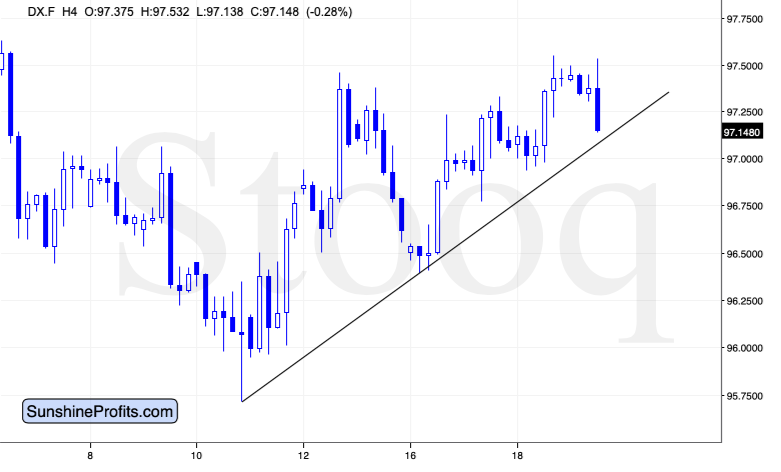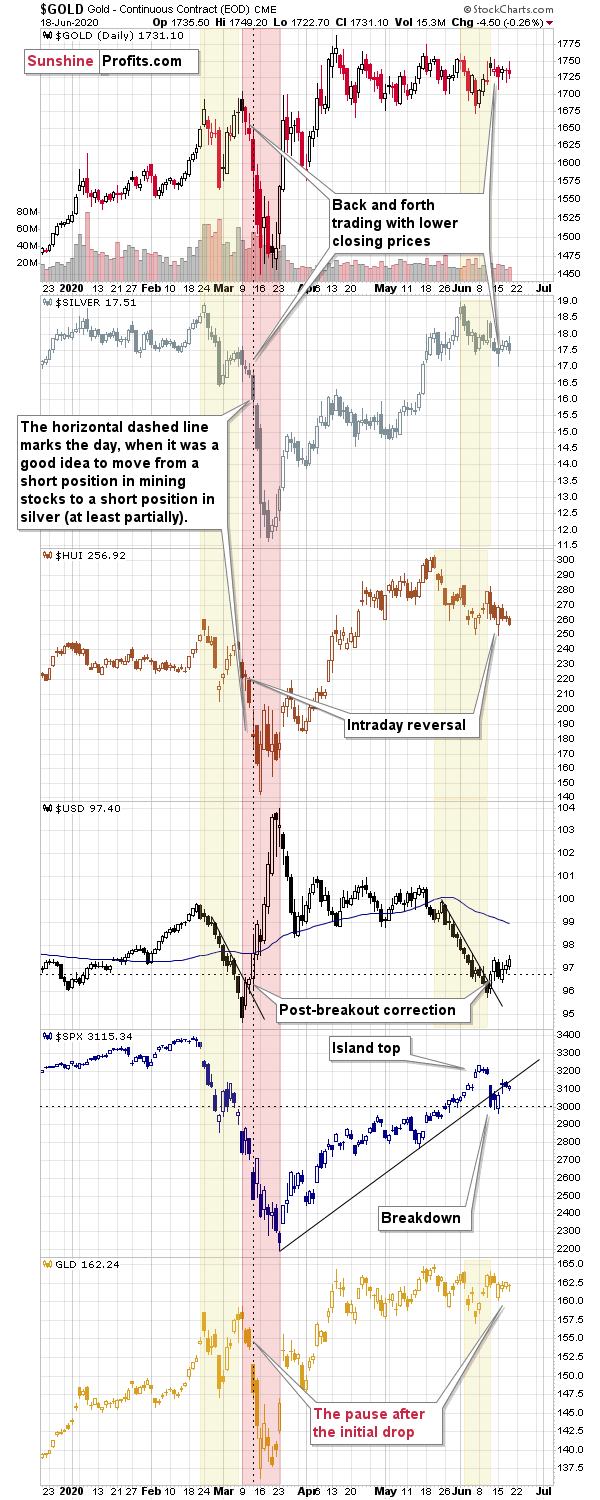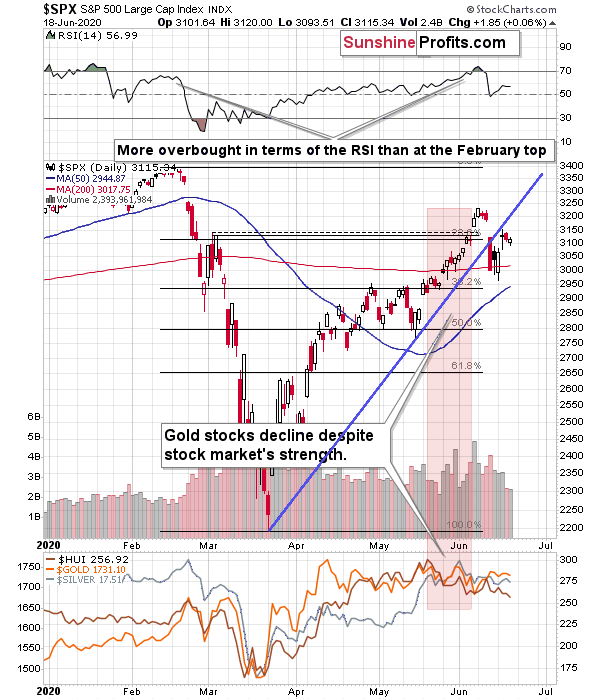Briefly: in our opinion, full (300% of the regular position size) speculative short positions in mining stocks are justified from the risk/reward point of view at the moment of publishing this Alert.
We realize that you might be getting tired of reading the same thing over and over again, but since the market is not moving (and it applies to practically all important markets from the precious metals investors' point of view), we can't really do anything else than repeat the previous words that still remain up-to-date.
There are two things that we would like to point out, though. The first one is today's pre-market move higher in gold and silver and the corresponding move lower in the USD Index.
The USDX didn't manage to break above the previous highs, but it didn't break below the rising support line either. Consequently, the decline might be over or almost over and the U.S. currency could make another attempt to break higher - perhaps as early as later today. Either way, we expect the USDX to move much higher in the following days / weeks.
The second thing is the fact that yesterday's close in the mining stocks was the lowest daily close since the beginning of May in case of the GDX ETF, and in case of the HUI Index, it was the lowest daily close since mid-April. Miners are definitely showing weakness here.
Consequently, our previous points remain up-to-date and the outlook remains very bearish:
What makes the analysis more difficult, however, is that it doesn't repeat in the same manner in all markets.
The yellow rectangles mark the similarities across the markets.
In case of the USD Index and mining stocks, the relatively short (about 2 weeks) period in February and March took form that's similar to what happened over about 3 weeks in May and so far in June.
In case of silver, we have a practically 1:1 similarity in case of the initial downswing and the subsequent correction. The corrective upswing didn't take silver back to its previous highs in March, and it certainly wasn't the case this week.
Gold's self-similarity is somewhere in between what happened in the above-mentioned markets. Taking the 1:1 approach in terms of time - similarly to what we did in case of silver - reveals a double-top formation. Taking the May high as the starting point would provide us with a declining trend channel or a triple top formation, but at the same time it would align gold's W pattern instead of a V pattern with the USD Index's whole recent decline.
Regardless of which approach we take, the implications for gold are bearish nonetheless, and the shape of yesterday's candlestick confirms it. That was the third black candlestick that we saw since beginning of March. We saw the first one at the March top - right before the slide - and we saw the second one about 2 weeks later, when gold was finishing the bottoming process. Obviously, gold is not after a huge decline right now, so the above serves as a clear confirmation that yesterday's session was likely similar to March 9th top.
The S&P 500 Index just broke below the rising support line after forming an island top. It also invalidated the breakout above the March high. And why did that happen? There's little to say about any direct reason. And that's what makes this slide so important. It was not a reactive move, but rather one that showed that the buying power has likely dried up despite the massive liquidity injections that we saw previously this year. Interestingly, the S&P 500 Index closed at approximately 3000 level, which is more or less when the second part of the March slide started.
In other words, the S&P 500 is more or less where it was when gold, silver and mining stocks were right after their final pre-slide top. That's a powerful bearish confirmation.
And the USD Index? It just gained 0.77 yesterday. It hasn't gained this much during one day since mid-March 2020. In the previous Alerts, we emphasized that gold is likely to react to bigger rallies in the USD Index. So far, the reaction was most notable in mining stocks, but the black candlestick in gold is an important indication that the emphasis goes on "so far".
Finally, please note that during the March slide, there was a moment (close to the end of the March 12 session) when it was an excellent idea to move from the short position in mining stocks to a short position in silver. If history repeats itself, and we get similar indications as in March and miners plunge before silver does, we might move from the short position in miners to one in silver, for an extra boost in profitability.
During Friday's session, gold more or less moved sideways, while silver and miners declined, even despite the small rebound on the stock market (which was not enough to invalidate the breakdown below the rising support line). That's very close to what happened right before the most profound part of the March slide. Consequently, the above self-similarity is even more confirmed. The additional confirmation comes from today's pre-market trading. If the self-similar pattern is to continue, gold should fall hard this week, and that's what it's been doing so far today, even without USD's help. The implications are extremely bearish for the precious metals market for the next 1-3 weeks.
In yesterday's analysis, commenting on Monday's price moves, we further added:
Now, what happened yesterday [on Monday]?
Gold and silver moved back and forth on an intraday basis.
Miners formed a daily reversal.
The USD Index corrected after breaking above the declining resistance line - without invalidating the breakout.
The general stock market moved back up, but not significantly so. It confirmed the previous breakdown below the rising support line instead of invalidating it.
All the above is in tune with what happened close to the middle of March in all above-mentioned markets, and we marked it on the chart. The first few days of the area that we marked with red rectangle are in tune with what we just saw. Consequently, what might appear to be "strength" in PMs, stocks, and miners and weakness in the USD Index, in reality isn't "strength" at all. At least it's way too early to view it as such. It's simply yet another day during which the markets are moving more or less as they moved in March.
Did Tuesday's performance really confirm the above? Let's see:
Gold and silver continued their back and forth trading. They closed only slightly higher.
The GLD ETF (bottom of the above chart) shows that the similarity to the mid-March performance remains intact. In the very early days of the big decline, GLD declined and then moved back and forth for two US sessions. This time GLD closed higher, but the size of the days (the price range) is still just like in March. Moreover, please note that Monday's intraday low was very close to the intraday low of the one of the topping candlesticks, which is exactly what we saw in March. Back then the low of the small consolidation was very close to the March 6th intraday low and right now the low of the small consolidation was very close to the and June 10th intraday low.
Miners showed weakness relative to gold and the general stock market by declining despite both above closed higher.
The USD Index moved back up so the breakout appears to be verified. It hasn't rallied profoundly yet, but the delay - compared to how things developed in March - is only slight.
The general stock market moved higher and it might appear to have broken back above the rising support/resistance line, thus invalidating the breakdown, but it's simply a matter of using the linear scale instead of the regular logarithmic one. The latter is more useful as it gives the same weight to the same moves in relative terms (percentagewise) which is in tune with how it should work. It's much more important how much the market moves in percentage terms than in absolute terms. $30 move in gold was a big deal when it was trading at about $300 (10%!), but it's nothing to call home about now (less than 2%).
Here's how stocks performed in terms of the logarithmic scale.
There was no invalidation, just a comeback to the previously broken line and the early-March high. Consequently, the points that we made in the previous days remain up-to-date, and so does the self-similarity in PMs and USD Index to what happened in the first half of March.
By the way, the supply glut of gold is yet another factor supporting lower prices in the near term.
Summary
Summing up, the outlook for the precious metals market is extremely bearish for the next 1-3 weeks due to the huge number of bearish signs (and their strength) that we have right now, and how likely PMs are to repeat their March slide to a significant extent).
After the sell-off (that takes gold below $1,400), we expect the precious metals to rally significantly. The final decline might take as little as 1-3 weeks, so it's important to stay alert to any changes.
Most importantly - stay healthy and safe. We made a lot of money on the March decline and the subsequent rebound (its initial part) price moves (and we'll likely make much more in the following weeks and months), but you have to be healthy to really enjoy the results.
As always, we'll keep you - our subscribers - informed.
To summarize:
Trading capital (supplementary part of the portfolio; our opinion): Full speculative short positions (300% of the full position) in mining stocks is justified from the risk to reward point of view with the following binding exit profit-take price levels:
Senior mining stocks (price levels for the GDX ETF): binding profit-take exit price: $10.32; stop-loss: none (the volatility is too big to justify a SL order in case of this particular trade); binding profit-take level for the DUST ETF: $231.75; stop-loss for the DUST ETF: none (the volatility is too big to justify a SL order in case of this particular trade)
Junior mining stocks (price levels for the GDXJ ETF): binding profit-take exit price: $9.57; stop-loss: none (the volatility is too big to justify a SL order in case of this particular trade); binding profit-take level for the JDST ETF: $284.25; stop-loss for the JDST ETF: none (the volatility is too big to justify a SL order in case of this particular trade)
For-your-information targets (our opinion; we continue to think that mining stocks are the preferred way of taking advantage of the upcoming price move, but if for whatever reason one wants / has to use silver or gold for this trade, we are providing the details anyway. In our view, silver has greater potential than gold does):
Silver futures downside profit-take exit price: $8.58 (the downside potential for silver is significant, but likely not as big as the one in the mining stocks)
Gold futures downside profit-take exit price: $1,382 (the target for gold is least clear; it might drop to even $1,170 or so; the downside potential for gold is significant, but likely not as big as the one in the mining stocks or silver)
Long-term capital (core part of the portfolio; our opinion): No positions (in other words: cash
Insurance capital (core part of the portfolio; our opinion): Full position
Whether you already subscribed or not, we encourage you to find out how to make the most of our alerts and read our replies to the most common alert-and-gold-trading-related-questions.
Please note that the in the trading section we describe the situation for the day that the alert is posted. In other words, it we are writing about a speculative position, it means that it is up-to-date on the day it was posted. We are also featuring the initial target prices, so that you can decide whether keeping a position on a given day is something that is in tune with your approach (some moves are too small for medium-term traders and some might appear too big for day-traders).
Plus, you might want to read why our stop-loss orders are usually relatively far from the current price.
Please note that a full position doesn't mean using all of the capital for a given trade. You will find details on our thoughts on gold portfolio structuring in the Key Insights section on our website.
As a reminder - "initial target price" means exactly that - an "initial" one, it's not a price level at which we suggest closing positions. If this becomes the case (like it did in the previous trade) we will refer to these levels as levels of exit orders (exactly as we've done previously). Stop-loss levels, however, are naturally not "initial", but something that, in our opinion, might be entered as an order.
Since it is impossible to synchronize target prices and stop-loss levels for all the ETFs and ETNs with the main markets that we provide these levels for (gold, silver and mining stocks - the GDX ETF), the stop-loss levels and target prices for other ETNs and ETF (among other: UGLD, DGLD, USLV, DSLV, NUGT, DUST, JNUG, JDST) are provided as supplementary, and not as "final". This means that if a stop-loss or a target level is reached for any of the "additional instruments" (DGLD for instance), but not for the "main instrument" (gold in this case), we will view positions in both gold and DGLD as still open and the stop-loss for DGLD would have to be moved lower. On the other hand, if gold moves to a stop-loss level but DGLD doesn't, then we will view both positions (in gold and DGLD) as closed. In other words, since it's not possible to be 100% certain that each related instrument moves to a given level when the underlying instrument does, we can't provide levels that would be binding. The levels that we do provide are our best estimate of the levels that will correspond to the levels in the underlying assets, but it will be the underlying assets that one will need to focus on regarding the signs pointing to closing a given position or keeping it open. We might adjust the levels in the "additional instruments" without adjusting the levels in the "main instruments", which will simply mean that we have improved our estimation of these levels, not that we changed our outlook on the markets. We are already working on a tool that would update these levels on a daily basis for the most popular ETFs, ETNs and individual mining stocks.
Our preferred ways to invest in and to trade gold along with the reasoning can be found in the how to buy gold section. Additionally, our preferred ETFs and ETNs can be found in our Gold & Silver ETF Ranking.
As a reminder, Gold & Silver Trading Alerts are posted before or on each trading day (we usually post them before the opening bell, but we don't promise doing that each day). If there's anything urgent, we will send you an additional small alert before posting the main one.
Thank you.
Sincerely,
Przemyslaw Radomski, CFA
Editor-in-chief, Gold & Silver Fund Manager






